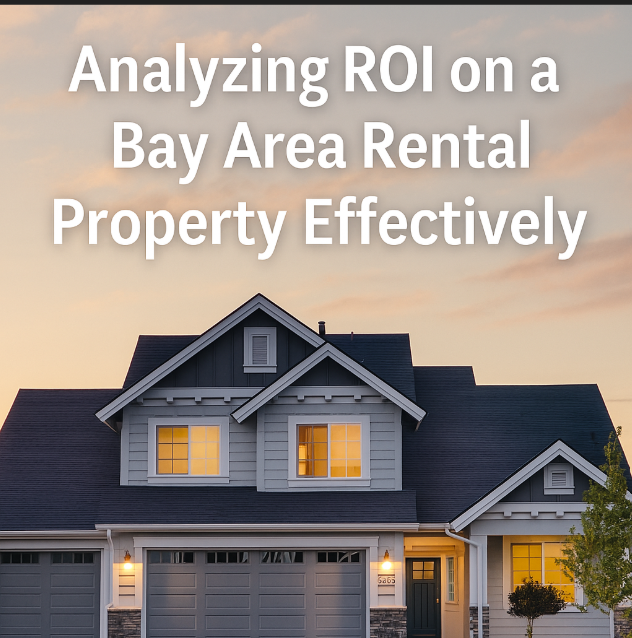ROI, which stands for Return On Investment, is a financial metric used in evaluating the profitability of an investment. It generally measures the Gain or Loss generated from an Investment.
Investing in a rental property in the Bay Area can be lucrative but success depends on careful analysis. High purchase prices, fluctuating rents, and strong demand define the region. To make informed decisions, you’ll need to accurately analyze return on investment before buying.
This post walks through:
- The basics of ROI in real estate.
- Regional factors affecting ROI.
- Step by step ROI analysis.
- How to apply it in the Bay Area market.
Understanding ROI in Real Estate
Return on Investment measures how effectively your investment generates profit. In real estate, ROI accounts for:
- Purchase price and acquisition costs
- Rental income
- Operating expenses
- Financing costs
- Tax implications and appreciation
In the Bay Area, where homes often cost over $1 million, knowing your ROI helps determine whether a property will cover its costs and deliver meaningful returns over time.
Key ROI Metrics
Here are common ROI metrics used in real estate:
1. Cash on Cash – CoC
How much cash you get back each year relative to what you’ve invested in cash.
Total Cash Invested
CoC Return= ______________________
Annual Pre-Tax Cash Flow
2. Capitalization Rate – Cap Rate
Annual net operating income relative to the market value.
Purchase Price
Cap Rate= ______________________
Net Operating Income (NOI)
Cap rate helps compare property types independent of financing.
3. Total ROI – Annualized
Includes both cash flow and appreciation over a given period, factoring in taxes and loan payoff.
Factors Affecting ROI in Bay Area Rentals
ROI is influenced by many local factors:
1. Purchase Price vs. Rent Levels
Median home prices range from $1.25M in San Jose to $3.5M in Palo Alto. Meanwhile, one-bedroom rents vary from $2,400 outer suburbs to $4,000+ downtown core. These values directly affect your income and returns.
2. Operating Expenses
Expect higher costs for:
- Property taxes
- Homeowners insurance
- Maintenance and repairs
- Utilities
- HOA dues
3. Vacancy & Turnover
Bay Area turnover rates are modest, especially near universities and tech. Still, you should allocate 5–7% of annual rent for vacancy.
4. Financing Structure
High property values often require jumbo loans, which come with higher interest rates. Your loan amount and terms dramatically affect CoC return.
5. Tax Treatment
Mortgage interest, depreciation, property taxes, and certain expenses are deductible but rising interest rates may limit deductions for some investors.
6. Appreciation Expectations
Silicon Valley historically appreciates at 5–7% annually. But growth varies by location and economic conditions.
Steps to Analyze ROI on a Bay Area Rental
Here’s a structured approach to calculating your potential ROI:
Step 1: Calculate Gross Rental Income
Estimate realistic monthly rent by researching local listings:
Zillow, Redfin, Craigslist, Apartments.com.
Example : A two bedroom in San Jose rents for $3,300 for a month.
Annual Gross Income = $39,600
Step 2: Estimate Operating Expenses
Use typical expense percentages or itemize:
| Expense Category | Annual Cost |
| Property Taxes (1.1%) | $13,750 |
| Insurance & HOA | $6,000 |
| Maintenance/Repairs (5%) | $2,000 |
| Vacancy (5%) | $1,980 |
| Property Management (8%) | $3,168 |
| Total Operating Expenses | $26,898 |
Step 3: Calculate Net Operating Income (NOI)
NOI = $39,600 − $26,898 = $12,702
This figure is before debt and taxes.
Step 4: Calculate Cap Rate
$12,702
Cap Rate=____________≈1.0%
$1,250,000
A low cap rate, but common in coastal,high demand regions.
Step 5: Account for Financing Costs
Assume a 20% down payment $250,000 and a 4.5% 30-year loan on $1M:
- Monthly mortgage : $5,067.
- Annual debt service : $60,804.
Step 6: Calculate Cash Flow
Cash Flow = $12,702 − $60,804 = − $48,102
A negative cash flow common in competitive markets but appreciation might offset it.
Step 7: Calculate Cash on Cash Return
−$48,102
CoC Return= ________ =−19.2%
$250,000
A high negative CoC; rental cash flow alone won’t balance the investment.
Step 8: Estimate Appreciation & Tax Savings
Assume 5% annual appreciation $62,500 gain a year, plus:
- Depreciation benefit $17,455 a year.
- Tax savings from mortgage interest and property taxes.
- Reevaluate net gain after 5–7 years.
This could push total ROI positive, even if cash flow remains negative.
Step 9: Total Annual ROI Approximate
Suppose after tax and appreciation, the net annual benefit is $20,000.
$20,000−$48,102
Total ROI= ______________=−11%
$250,000
Still negative short term, but consider long term capital gains and equity buildup over 30 years.
Special Considerations for Bay Area Investors
- Bridge toward Future Gains
- Many investors accept negative cash flow initially, banking on appreciation.
- Many investors accept negative cash flow initially, banking on appreciation.
- Value Add Strategies
- Rent increases, remodels, or converting units can improve ROI.
- Rent increases, remodels, or converting units can improve ROI.
- Location Continuum
- Cap rates rise in less expensive cities like San Jose, Milpitas, Tracy, while appreciation may be stronger closer to major employers.
- Cap rates rise in less expensive cities like San Jose, Milpitas, Tracy, while appreciation may be stronger closer to major employers.
- Legal and Tax Complexity
- California has rent control, eviction protections, and property tax Proposition 13. Consult tax pros.
- California has rent control, eviction protections, and property tax Proposition 13. Consult tax pros.
- Diversification
- Multi unit properties or REITs may reduce risk while improving return balance.
- Multi unit properties or REITs may reduce risk while improving return balance.
Conclusion
ROI analysis is essential for assessing any Bay Area rental investment. While cash flow may be weak upfront, strong appreciation and equity gains can transform the investment over time. As a first time investor you should:
- Model best and worst case financial scenarios.
- Understand the balance between negative cash flow vs. long term gain.
- Know your cap rates vs. CoC return targets.
- Factor in financing, taxes, and future growth potential.
With diligent research and strategic planning, Bay Area rentals can still be powerful long term investment vehicles despite steep upfront costs.







Leave a Reply